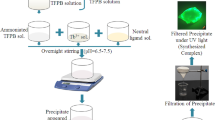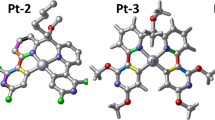Abstract
The luminescence lifetimes of europium(III) complexes with new monophosphorus acid derivatives of H4dota were measured by means of time-resolved laser-induced luminescence spectroscopy in H2O and D2O. The hydration numbers of these complexes were estimated using different empirical equations [Horrocks and Sudnick (1979) J. Am. Chem. Soc. 101 (1979) 334; Choppin and Barthelemy(1989) Inorg. Chem. 28, 3354–3357; Choppin and Bünzli Lanthanide probes in life, chemical and earth sciences. Theory and practice (1989); Kimura and Kato J. Alloys Comp. 275–277 (1998) 806; Parker (1999) J. Chem. Soc., Perkin Trans. 2, 493–503; Supkowski and Horroks (2002) Inorg. Chim. Acta. 340, 44–48]. It was shown that all the relationships gave similar results with a satisfactory precision. The hydration numbers of complexes of H3do3a and H4dota agreed with the literature values. One water molecule is coordinated in complexes of the new ligands. The results showed that the Choppin formula based on measurements only in H2O can be satisfactorily used for estimation of the hydration numbers.
Similar content being viewed by others
References
D. S. Edwards and S. Liu (2001). Bifunctional Chelators for Therapeutic Lanthanide Radiopharmaceuticals. Bioconjugate Chem. 12, 7–34.
A. E. Merbach and É. Tóth (Eds.), (2001). The Chemistry of Contrast Agents in Medical Magnetic Resonance Imaging. Wiley, Chichester.
P. Caravan, J. J. Ellison, T. J. McMurry, and R. B. Lauffer (1999). Gadolinium(III) Chelates as MRI Contrast Agents: Structure, Dynamics, and Applications. Chem. Rev. 99, 2293–2352.
J. C. G. Bünzli and G. R. Choppin (Eds.), (1989). Lanthanide probes in life, chemical and earth sciences. Theory and practice. Elsevier, Amsterdam.
P. R. Selvin (2002). Principles and Biophysical Applications of Luminescent Lanthanide Probes. Ann. Rev. Biophys. Biomol. Struct. 31, 275–302.
D. Parker (2000). Luminescent lanthanide sensors for pH, pO2 and selected anions Coord. Coord. Chem. Rev. 205, 109–130.
D. Parker, R. S. Disckins, H. Puschmann, C. Crossland, and J. A. K. Howard (2002). Being Excited by Lanthanide Coordination Complexes: Aqua Species, Chirality, Excited-State Chemistry, and Exchange Dynamics. Chem. Rev. 102, 1977–2010.
S. Faulkner and J. L. Matthews (2004). in J. A. McCleverty and T. J. Meyer (Eds.), Comprehensive Coordination Chemistry II, Elsevier, Amsterdam, Vol. 9, pp. 913–944.
S. Lis (2002). Luminescence spectroscopy of lanthanide(III) ions in solution. J. Alloys Comp. 341, 45–50.
I. Lukeš, J. Kotek, P. Vojtíek, and P. Hermann (2001). Complexes of tetraazacycles bearing methylphosphinic/phosphonic acid pendant arms with copper(II), zinc(II) and lanthanides(III). A comparison with their acetic acid analogues. Coord. Chem. Rev. 216–217, 287–312.
J. F. Desreux (1980). Nuclear magnetic resonance spectroscopy of lanthanide complexes with a tetraacetic tetraaza macrocycle. Unusual conformation properties. Inorg. Chem. 19, 1319–1324.
J. Rudovský, P. Cígler, J. Kotek, P. Hermann, P. Vojtíek, I. Luke, J. A. Peters, L. V. Elst, and R. N. Muller (2005). Lanthanide(III) Complexes of a Mono(methylphosphonate) Analogue of H4dota: The Influence of Protonation of the Phosphonate Moiety on the TSAP/SAP Isomer Ratio and the Water Exchange Rate. Chem. Eur. J. 11, 2373–2384.
M. Málková (2002). Diploma Thesis. Charles University, Prague.
X. Sun, M. Wuest, Z. Kovacs, A. D. Sherry, R. Motekaitis, Z. Wang, A. E. Martell, M. J. Welch, and C. J. Anderson (2003). In vivo behavior of copper-64-labeled ethanephosphonate tetraaza macrocyclic ligands. J. Biol. Inorg. Chem. 8, 217–225.
S. Lis, Z. Hnatejko, and Z. Strył a (2001). Device for measurements of selective luminescence excitation spectra of europium(III) based on nitrogen and dye laser system. Optica Applicata 31, 643–648.
W. W. De Horrocks Jr. and D. R. Sudnick (1979). Lanthanide ion probes of structure in biology. Laser-induced luminescence decay constants provide a direct measure of the number of metal-coordinated water molecules. J. Am. Chem. Soc. 101, 334–340.
W. De Horrocks Jr. and D. R. Sudnick (1981). Lanthanide ion luminescence probes of the structure of biological macromolecules. Acc. Chem. Res. 14, 384–392.
P. Barthelemy and G. R. Choppin (1989). Luminescence study of complexation of europium and dicarboxylic acids. Inorg. Chem. 28, 3354–3357.
T. Kimura and Y. Kato (1998). Luminescence study on hydration states of lanthanide(III)-polyaminopolycarboxylate complexes in aqueous solution. J. Alloys Comp. 275–277, 806–810.
A. Beeby, I. M. Clarkson, R. S. Dickins, S. Faulkner, D. Parker, L. Royle, A. S. de Sousa, J. A. G. Williams, and M. Woods (1999). Non-radiative deactivation of the excited states of europium, terbium and ytterbium complexes by proximate energy-matched OH, NH and CH oscillators: An improved luminescence method for establishing solution hydration states. J. Chem. Soc., Perkin Trans. 2, 493–503.
R. M. Supkowski and W. W. De Horrocks Jr. (1999). Displacement of Inner-Sphere Water Molecules from Eu3+ Analogues of Gd3+ MRI Contrast Agents by Carbonate and Phosphate Anions: Dissociation Constants from Luminescence Data in the Rapid-Exchange Limit. Inorg. Chem. 38, 5616–5619.
R. M. Supkowski and W. W. De Horrocks, Jr. (2002). On the determination of the number of water molecules coordinated to europium(III) ions in solution from luminescence decay lifetimes. Inorg. Chim. Acta 340, 44–48.
T. Kimura and Y. Kato (1998). Luminescence study on the inner-sphere hydration number of lanthanide(III) ions in concentrated aqueous salt solutions in fluid and frozen states. J. Alloys Comp. 278, 92–97.
S. Lis and G.R. Choppin (1992). Luminescence Lifetimes of Aqueous Europium Perchlorate, Chloride and Nitrate Solutions. Mat. Chem. Phys. 31, 159–161.
A. Nehlig, M. Elhabiri, I. Billard, A.-M. Albrecht-Gary, and K. Lutzenkrichen (2003). Photoexcitation of europium(III) in various electrolytes: Dependence of the luminescence lifetime on the type of salts and the ionic strength. Radiochim. Acta 91, 37–43.
E. N. Rizkalla and G. R. Choppin (1991). in K. A. Gschneidner Jr. and L. Eyring (Eds.), Hydration and Hydrolysis of Lanthanides Handbook on Physics and Chemistry of Rare Earths, Vol. 15, Elsevier, Amsterdam, 393–442.
T. Ozaki, M. Arisaka, T. Kimura, A. J. Francis, and Z. Yoshida (2002). Empirical method for prediction of the coordination environment of Eu(III) by time-resolved laser-induced fluorescence spectroscopy. Anal. Bioanal. Chem. 374, 1102–1104.
É. Tóth, O. M. N. Dhubhghail, G. Besson, L. Helm, and A. E. Merbach (1999). Coordination equilibrium—a clue for fast water exchange on potential magnetic resonance imaging contrast agents? Magn. Reson. Chem. 37, 701–708.
S. Aime, M. Botta, M. Fasano, M. P. M. Marques, C. F. G. C. Geraldes, D. Pubanz, and A. E. Merbach (1997). Conformational and Coordination Equilibria on DOTA Complexes of Lanthanide Metal Ions in Aqueous Solution Studied by 1H-NMR Spectroscopy. Inorg. Chem. 36, 2059–2068.
F. Avecilla, J. A. Peters, and C. F. G. C. Geraldes (2003). X-ray Crystal Structure of a Sodium Salt of [Gd(DOTP)]5-: Implications for Its Second-Sphere Relaxivity and the 23Na NMR Hyperfine Shift Effects of [Tm(DOTP)]5-. Eur. J. Inorg. Chem. 4179–4186.
P. Gawryszewska, L. Jerzykiewicz, M. Pietraszkiewicz, J. Legendziewicz, and J. P. Riehl (2000). Photophysics and Crystal Structure of a Europium(III) Cryptate Incorporating 3,3′-Biisoquinoline-2,2′-dioxide. Inorg. Chem. 39, 5365–5372.
S. Lis, J. Konarski, Z. Hnatejko, and M. Elbanowski (1994), A Luminescence Study of Eu(III) and Tb(III) Complexes with Aminopolycarboxylic Acid Ligands. J. Photochem. Photobiol. A: Chem 79, 25–31.
Author information
Authors and Affiliations
Corresponding author
Rights and permissions
About this article
Cite this article
Táborský, P., Svobodová, I., Hnatejko, Z. et al. Spectroscopic Characterization of Eu(III) Complexes with New Monophosphorus Acid Derivatives of H4dota. J Fluoresc 15, 507–512 (2005). https://doi.org/10.1007/s10895-005-2824-8
Received:
Accepted:
Issue Date:
DOI: https://doi.org/10.1007/s10895-005-2824-8




